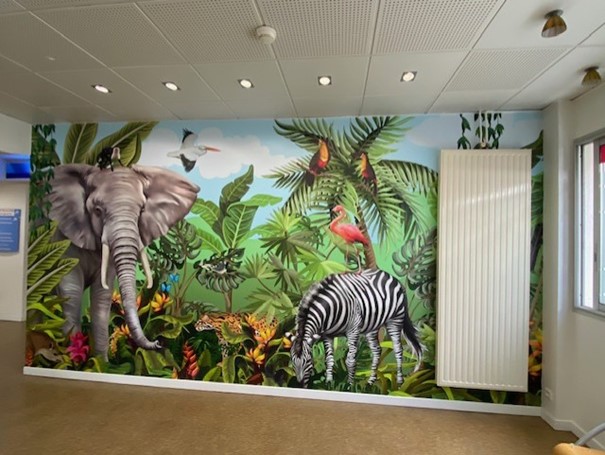
The Power of Playful Waiting
A playful waiting area is a proven strategy to improve the user experience in public spaces—such as airports, stations, and hospitals—and to make waiting feel shorter.
By carefully aligning design, graphics, and interactive elements with the environment, waiting turns into a useful and pleasant moment.
This article explores two concrete projects — a baby changing area with personalized ceiling panels at Beauvais Airport, and a wall decoration at Morlaix Hospital — to show how playful waiting spaces reduce stress, increase satisfaction, and improve the overall experience for both visitors and staff.
Why playful waiting works: evidence and impact
Research consistently shows that a well-designed environment significantly reduces perceived waiting time and related stress.
A study of outpatient waiting rooms found that the quality of the space influences satisfaction and time perception.
Academic reviews and whitepapers (such as those from Haworth) highlight that visual distraction, clear information, and interactive elements help reduce stress and make waiting more pleasant.
In practice, a playful waiting space works on three levels:
- Diverting attention: through play, movement, and visual elements
- Informing: with clear, reassuring communication
- Resting: with warm colors and comfortable furniture
This approach is especially effective for families: a child who plays means a parent who relaxes — and a smoother appointment overall.
Project 1: Beauvais Airport — personalized ceiling panels in the baby changing area
Beauvais Airport features both public and private baby care rooms, ideal for family-oriented design solutions.
For these spaces, IKC developed custom ceiling panels with soft colors, dreamy figures, and an imaginative storyline that draws the gaze upward—creating calm and visual distraction during diaper changes.
Result: children calm down faster, parents feel less stressed, and staff are interrupted less often.
A wall game offers additional distraction for siblings—a tangible example of playful waiting, perfectly suited for high-traffic environments like airports.
The design also meets ERP regulations (safety and hygiene) and is easy to clean and maintain.
Project 2: Morlaix Hospital — wall decoration to reduce anxiety in the waiting room
In the pediatric waiting room of Morlaix Hospital, a calming wall decoration was installed.
Research shows that the quality of waiting areas directly impacts the patient experience: well-designed spaces increase satisfaction and reduce perceived waiting time.
That’s exactly the goal of a playful hospital waiting space — to ease tension, support medical interactions, and foster cooperation with young patients.
Practical tips for creating playful waiting spaces in healthcare and transport
For facility managers and building administrators, these are quick and effective actions:
- Focus on family touchpoints – baby changing areas, pediatric waiting rooms, and family zones near gates.
- Design with a story – large visuals, soft colors, and a visual narrative.
- Use micro-interactions – tactile or visual elements (ceiling panels, playful stickers) attract attention without causing distraction.
Studies (Utrecht University) show that relevant distraction shortens the perceived waiting time.
Tip: integrate a game into the decor — for example, hidden-object pictures, riddles, or mazes. - Evaluate and measure – test the impact with short surveys about satisfaction and time perception.
Benefits for organizations: satisfaction, efficiency, and image
Investing in a playful waiting space pays off in multiple ways:
- Higher visitor and patient satisfaction
- Less restlessness and fewer interruptions for staff
- Positive impact on visitors’ mental well-being
- Better work experience for teams through smoother interactions
Scientific reviews confirm that the physical environment plays a key role in how people perceive waiting and how satisfied they feel.
Further reading
Xuan, X., Li, Z., Chen, X., Cao, Y., & Feng, Z. (2021). Study of the physical environment of waiting areas and its effects on patient satisfaction, experience, perceived waiting time, and behavior in China. HERD, 14(3), 108–123. PubMed
Erard, J. (2017). Reducing perceived wait duration to improve patient experience [White paper]. Haworth. Haworth
Van Nimwegen, C., & Van Rijn, E. (2023). Time swipes when you’re having fun: Reducing perceived waiting time while making it more enjoyable. Behaviour & Information Technology, 42(3), 307–315. Utrecht University